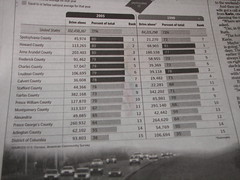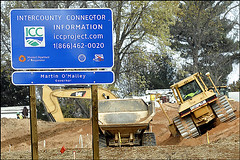Montgomery County may be rich, but it's likely backwards or at the least not very forward looking

Washington Post graphic.
Maybe RideOn is a bus service. Not a transportation service.... (a takeoff of the idea expressed by Ted Leavitt in the book Marketing Imagination, that GM wasn't a car company, but a transportation company...)
In the 1960s, when the subway system was being planned in the DC region, Arlington County, which was then losing population and tax base, "bet the farm" and decided to have the subway routed not along I-66 but under Wilson Boulevard, and in response, changed the maximum density allowable under zoning (I think through a type of planned unit development) to leverage access to and investment in the subway system.
Somewhere along the line Arlington County also figured out the need to match the change in land use with a more focused transportation demand management planning protocol, linking density increases with transportation plans to ensure reduced automobile use and maximize the utilization of transit.
These days, ArCo is gaining population, jobs, and tax base, and has amongst the lowest tax burden in both the State of Virginia, and the DC region.
ArCo doesn't allow projects built to maximum allowable density unless the development plan is designed to maximize transit (and walking and bicycle-based trips).

Driving alone to work. Washington Post graphic.
2. Montgomery County did do something intelligent with regard to transportation and their bus service though. They made the bus route structure complementary to the subway system within the County, and in the areas served by the subway system, the bus routes support trips to and from the stations. In fact, MoCo has one of the more successful suburban bus systems across the U.S. But the County shouldn't rest on such laurels.
And, while they haven't required transportation demand management planning to the extent that ArCo has, MoCo does have four transportation management districts (Bethesda, North Bethesda, Friendship Heights, and Silver Spring) and they work actively to shift trips from automobiles to transit.
3. BUT, it looks like MoCo is thinking very short-sightedly in terms of mobility, both in terms of the county's massive support for the freeway Inter County Connector, as well as the talk in the County about maybe going for bus rapid transit instead of light rail for the Purple Line, as I discussed in a blog entry last week, as well as this chilling article in today's Examiner, "MontCo officials may be pushing for buses, not light rail."
This is a bet the farm moment, an investment in the County's mobility infrastructure that can shape--positively or negatively--the County's future
Let's be real, bus rapid transit is not a rail system on wheels. It's a bus. Even if it's bigger and fancier, it's still a bus. And it will have limited capacity, won't attract as many riders, and will require the replacement of buses every 10-15 years, will require more drivers, and will require 2 or 3 times the number of buses compared to light rail vehicles, to move the same amount of people.
In short, while Arlington County is a government focused on the transformational delivery of services in paradigm shifting ways, maybe Montgomery County is just like most other counties--albeit close to Washington DC and relatively rich--but middling when it comes to transformation and more focused on cars and roads rather than (re)building an optimal mobility system.
Two other areas where MoCo really dropped the ball are:
1. Not including a bicycle station in the $150 million Sarbanes multimodal transit center in Silver Spring. It was "too much money" although they do plan to include a bicycle station somewhere else in the vicinity of the transit center.

Katherine Frey, Washington Post.
2. Determining that a bicycle path along parts of the Inter County Connector would damage the environment and therefore shouldn't be included. Can't we stop saying that bicycles and building trails for bicycles are more damaging than building highways capable of moving 2,200 cars/hour?
Note that MoCo does do a good job in terms of its "urban district" planning such as for Silver Spring and Bethesda. But, it seems as if the County is still more backwards than forwards when it comes to planning next generation transit for the County and for the region.
The decisions they make will shape MoCo for generations.
Remember that at the end of the day, a bus is still a bus, even if it is painted in flashy colors and is big and bulky.
Labels: sustainable land use and resource planning, transportation demand management, transportation planning



0 Comments:
Post a Comment
<< Home